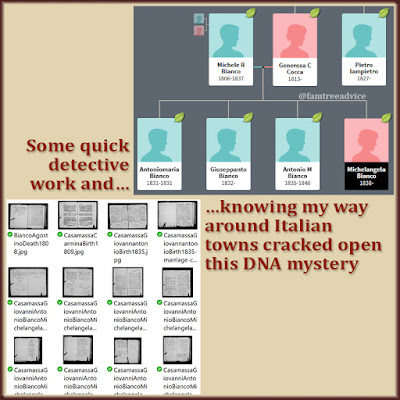I was working on a distant branch of my family tree, and I wondered what was my exact relation to this person. I used the Relationship Calculator in Family Tree Maker for a visualization.
The tool creates a stepping-stone trail from you (or whomever you choose) to any person in your tree. I thought it'd be fun to see the Relationship Calculator for my grandparents, Pietro Iamarino and Lucy Iamarino. They didn't both have the unusual last name of Iamarino for no reason.
I learned a few years ago that my grandparents were 3rd cousins. The Relationship Calculator in Family Tree Maker lists 3 relationships for my grandparents:
- Pietro is Lucy's husband
- Pietro is Lucy's 3rd cousin (they share 2nd great grandparents)
- Pietro is the nephew of the husband of the 1st cousins twice removed of Lucy
Of course I needed a visual aid to figure out that last relationship. Lucy Iamarino's grandfather had a 1st cousin named Libera Nigro. She married a relative in the Iamarino family. I recognized his name right away. He was the Uncle Joe my dad remembers from his early childhood.
Uncle Joe, or Giuseppantonio Iamarino, was the go-to relative in the Bronx, New York. When my grandfather's father came to America, he stayed with his brother Joe. When my grandmother's father came to America, he also stayed with Joe—his 2nd cousin!
I have a bit of unfinished research business with Uncle Joe. Years ago in the New York City Municipal Archives, I learned Uncle Joe had remarried in November 1928. I'd never found the death record for his 1st wife, Libera Nigro.
Now that indexed New York City vital records are online, I thought I'd search for Libera's death. Instead I found a death record for her daughter.
I have their daughter Giovannangela Iamarino's 1895 birth record from the Antenati website. And I have her 1903 ship manifest. It shows her coming to America with her mother (Libera Nigro) and brother to join her father (my Uncle Joe). Giovannangela, also called Jennie, is with her parents in the 1905, 1910 and 1915 censuses. I had no idea what became of her.
 |
| The shocking discovery of cousin Jennie's horrific death is tempered by the discovery of her husband: another cousin. |
Until now. When I clicked that death record entry, I learned one key fact right away: Jennie had married a man named Piteo.
The index of her death record has several critical facts:
- It confirms her birth date, so I'm certain she's the right person.
- She was only 27 years old when she died on 18 February 1923.
- She's buried in St. Raymond's Cemetery in the Bronx along with the vast majority of my family.
It was the cause of death that threw me for a loop. The transcription is pretty bad (can't you at least spell kitchen?), but understandable. It says, "Difun Burns of Body (Accidental) Cloths Caughs Fin This And from Kithcen for Range."
Poor Jennie's clothes caught fire while she was cooking ("Cloths Caughs Fin," argh!). She died from burns to her body. Instantly, I pictured this scene in my mind. Was she lighting the stove with a match? Did the flames get too high? Did she use a mapina (dish towel) to beat the flames, but wind up spreading it to her own clothing? She must have been screaming. The entire apartment house must have heard her. Did anyone try to save her? Did she have a small child or children there with her?
But this story seemed familiar. I don't have contact with anyone who would have remembered Jennie. Did I really hear this before?
It was her son's U.S. Social Security Applications and Claims Index that led me further. It lists Jennie Iamarino as mother, Vincent Piteo as father. Their child, Serafino Vincent Piteo, lived to the age of 84 (I'm so glad!). He was born in January 1920 and died in 2004. He probably missed the 1920 census, but I found him with his dad in the 1930 census.
 |
| A random, unexpected path led me to a tragic discovery in my family tree. |
Now that I had the name of Jennie's husband, I wondered where he came from. I found his World War I draft registration card on Ancestry. As I scanned the card for his place of birth, I nearly cried again. He's from the same town as Jennie and every Iamarino: Colle Sannita.
I realized I had his 1892 birth record in my possession. (See Collect the Whole Set.) Vincent's (Vincenzo's) mother is my 3rd cousin 3 times removed.
While I'm haunted by what happened to poor Jennie, I'm eager to fit her son into my family tree. I can't wait to see how many different relationships he and I have.
How I got to this point, working the Piteo men into my family tree, was very roundabout. And I never found a death record for Jennie's mother. It just goes to show you. You never know what amazing stories you'll find while playing around with genealogy.







